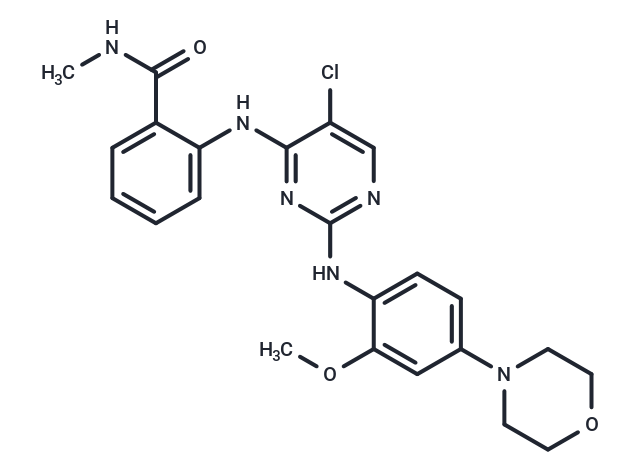Shopping Cart
Remove All Your shopping cart is currently empty
Your shopping cart is currently empty
NVP-TAE 226 (TAE226) is a potent FAK inhibitor (IC50: 5.5 nM), exhibiting even greater efficacy against Pyk2 (IC50: 3.5 nM), and is 10- to 100-fold less effective against IGF-1R, InsR, c-Met, and ALK.

| Pack Size | Price | USA Warehouse | Global Warehouse | Quantity |
|---|---|---|---|---|
| 1 mg | $41 | In Stock | In Stock | |
| 2 mg | $57 | In Stock | In Stock | |
| 5 mg | $103 | In Stock | In Stock | |
| 10 mg | $166 | In Stock | In Stock | |
| 25 mg | $277 | In Stock | In Stock | |
| 50 mg | $397 | In Stock | In Stock | |
| 100 mg | $597 | In Stock | In Stock | |
| 1 mL x 10 mM (in DMSO) | $103 | In Stock | In Stock |
| Description | NVP-TAE 226 (TAE226) is a potent FAK inhibitor (IC50: 5.5 nM), exhibiting even greater efficacy against Pyk2 (IC50: 3.5 nM), and is 10- to 100-fold less effective against IGF-1R, InsR, c-Met, and ALK. |
| Targets&IC50 | PYK2:3.5 nM, FAK:5.5 nM |
| In vitro | In in vivo models, NVP-TAE226 (100 mg/kg, p.o.) significantly hindered the growth of human pancreatic tumor MIA PaCa-2 without affecting body weight. Moreover, NVP-TAE226 demonstrated a dose-dependent inhibition of growth and lung metastasis in 4T1 murine mammary tumors, correlated with the suppression of FAK autophosphorylation on Y397 and Akt phosphorylation on serine 473. At a dosage of 75 mg/kg, NVP-TAE226 significantly increased the survival rate of mice bearing intracranial glioma xenografts. Additionally, in a human colorectal cancer SCID mouse model, NVP-TAE226 (100 mg/kg, p.o.) markedly reduced microvessel density. |
| In vivo | NVP-TAE226 (0.1-10 μM) inhibits microtubule formation in HMEC1 cells and suppresses serum starvation-induced autophosphorylation of FAK(Tyr397) in U87 cells at concentrations below 1 μM. It also inhibits IGF-I-induced phosphorylation of IGF-1R and its downstream target gene activities, including MAPK and Akt in U87 and U251 cells at concentrations under 1 μM. Moreover, NVP-TAE226 at 1 μM inhibits tumor cell invasion by more than 50% in vitro assays on an artificial basement membrane for glioblastoma cell lines. It induces G(2)-M phase arrest in glioblastoma cell lines, including those with wild-type p53, while those bearing mutant p53 undertake apoptosis, evidenced by the activation of caspase-3/7, poly(ADP-ribose) polymerase cleavage, and annexin V apoptosis assays. In the neuroblastoma cell line SK-N-AS, NVP-TAE226 at 5 μM inhibits FAK phosphorylation and at concentrations below 10 μM decreases cell viability, induces cell cycle arrest, and increases apoptosis. In U87 and U251 cells, it impedes tumor cell growth and weakens the G(2)-M cell cycle process related to reduced expression of cyclin B1 and phosphorylated cdc2(Tyr15) proteins at concentrations below 10 μM. |
| Kinase Assay | Kinase assay: Kinase activities are assayed in Buffer A or C at 30°C, at a final ATP concentration of 15 μM. Blank values are subtracted and activities calculated as pmoles of phosphate incorporated during a 10 min incubation. Controls are performed with appropriate dilutions of dimethylsulfoxide. In a few cases phosphorylation of the substrate is assessed by autoradiography after SDS-PAGE. GSK-3α/β is purified from porcine brain by affinity chromatography on immobilized axin. It is assayed, following a 1/100 dilution in 1 mg BSA/ml 10 mM DTT, with 5 μl 40 μM GS-1 peptide, a specific GSK-3 substrate, (YRRAAVPPSPSLSRHSSPHQSpEDEEE), in buffer A, in the presence of 15 μM [γ-32P] ATP (3,000 Ci/mmol; 1 mCi/ml) in a final volume of 30 μl. After 30 min incubation at 30°C, 25 μl aliquots of supernatant are spotted onto 2.5 × 3 cm pieces of Whatman P81 phosphocellulose paper, and 20 seconds later, the filters are washed five times (for at least 5 min each time) in a solution of 10 ml phosphoric acid/liter of water. The wet filters are counted in the presence of 1 ml ACS scintillation fluid. |
| Cell Research | Cell cultures are harvested with 0.05% trypsin and seeded in triplicate at 2 × 104 in 24-well culture plates for 24 h before drug treatment. Culture medium is used for mock treatment. Cells are harvested at the indicated day after treatment, and viable cells are counted using the Vi-cell viability analyze(Only for Reference) |
| Synonyms | TAE226 |
| Molecular Weight | 468.94 |
| Formula | C23H25ClN6O3 |
| Cas No. | 761437-28-9 |
| Smiles | CNC(=O)c1ccccc1Nc1nc(Nc2ccc(cc2OC)N2CCOCC2)ncc1Cl |
| Relative Density. | 1.349 g/cm3 |
| Storage | Powder: -20°C for 3 years | In solvent: -80°C for 1 year | Shipping with blue ice/Shipping at ambient temperature. | |||||||||||||||||||||||||||||||||||
| Solubility Information | DMSO: 87 mg/mL (185.52 mM), Sonication is recommended. Ethanol: < 1 mg/mL (insoluble or slightly soluble) H2O: < 1 mg/mL (insoluble or slightly soluble) | |||||||||||||||||||||||||||||||||||
| In Vivo Formulation | 10% DMSO+90% Corn Oil: 1 mg/mL (2.13 mM), Sonication is recommeded. Please add the solvents sequentially, clarifying the solution as much as possible before adding the next one. Dissolve by heating and/or sonication if necessary. Working solution is recommended to be prepared and used immediately. The formulation provided above is for reference purposes only. In vivo formulations may vary and should be modified based on specific experimental conditions. | |||||||||||||||||||||||||||||||||||
Solution Preparation Table | ||||||||||||||||||||||||||||||||||||
DMSO
| ||||||||||||||||||||||||||||||||||||
| Size | Quantity | Unit Price | Amount | Operation |
|---|

Copyright © 2015-2025 TargetMol Chemicals Inc. All Rights Reserved.